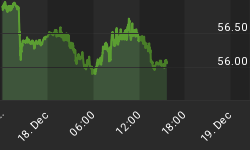The Fed traditionally embarks on an interest rate tightening cycle when inflation has started to run hot. This decline in the purchasing power of the dollar will nearly always manifest itself in: above trend nominal GDP, rising long-term interest rates and a positively sloping yield curve. These prevailing conditions are all indications of a market that is battling inflation; and thus prompts the Fed to start playing catch up with the inflation curve.
For example, the last time the Fed began a rate tightening cycle was back on June 30, 2004, when the Fed moved the Overnight Funds rate from 1% to 1 ¼%. At the time, the Ten-year Note yield was 4.62%, and the Two-year Note was 2.7%, creating a 1.92% spread between the Two and the Ten-year Note. To illustrate the fact that the long end of the yield curve was pricing in future inflation, the Ten-year yield climbed to 5.14% two years into the Fed's rate hiking cycle. And perhaps more importantly, real GDP was 3% and rising, while nominal GDP posted an impressive 6.6% in the second quarter of June 2004.
To reiterate, the last time the Fed began to raise rates it did so on the back of higher than normal nominal GDP, rising long-term interest rates and a positively sloping yield curve. With this in mind, let's take a look at the environment for the current tightening cycle.
The FOMC began its latest rate hiking campaign on December 17, 2015. At that time, the Ten-year note was 2.24%, and two-year Note was just 1%. Hence, the 2-10 year Note spread was 1.24%. And in the fourth quarter of 2015 nominal GDP was 2.3%, while real GDP was a paltry 1.4%.
As the markets sit with bated breath for the threatened second rate hike by the FOMC, the Ten-year Note Yield has actually decreased to 1.72% and the Two-Year Note dropped to 0.8%, creating a yield spread of a meager 92 basis points. This is the tightest yield spread since November of 2007. Making matters worse, nominal GDP during Q1 was 1.4% and Real GDP was 0.8%. Therefore, after just one measly rate hike from the FOMC, the yield curve is already flattening, and the rate of economic growth is shrinking.
 | |||
| Not Your Normal Rate Hike Scenario | |||
| June 2004 | December 2015 | Current Data | |
| Nominal GDP | 6.6% | 2.3% | 1.4% |
| Real GDP | 3.0% | 1.4% | 0.8% |
| CPI | 3.2% | 0.7% | 1.1% |
| 10 Year Note | 4.62% | 2.24% | 1.72% |
| 2 Year Note | 2.7% | 1.0% | 0.80% |
| Yield Spread | 1.92% | 1.24% | 0.92% |
| Pento Portfolio Strategies all rights reserved Sources: NY Fed, Treasury.gov, BEA, BLS | |||
This is in sharp contrast to what occurred in 2004. Back then the bond market didn't immediately succumb to the Fed's initial raise in rates. The long end of the curve, as well as inflation, pushed onward despite the Fed's attempts to slow them both down.
However, the yield curve did eventually invert by 2006 when the Fed Funds rate climbed to 5.25%. An inverted yield curve forebodes a recession because the money supply contracts once banks find it unprofitable to make new loans, and this causes asset bubbles to pop.
If this trend of a rising Fed Funds Rate and falling long-term rates continues, the yield curve will invert with just a few more interest rate hikes and over the course of the next few quarters. And this brings us to the most salient point of this commentary: the major problem is the Fed will most likely have around 400 basis points less ammo (room to lower interest rates) during this next economic contraction than it had to pull the economy out of the Great Recession of 2008.
From September 2007 to December 2008, the Fed reduced rates by 525 basis points to 0%. However, during this next recession, the Fed will only be able to take back the handful of 25 basis point increases it managed to push through before the gravitational forces of deflation plunged the economy into its next collapse.
Indeed, the Fed very well may be filled with such hubris to believe its ZIRP and QE's have healed the economy to the point that it can normalize interest rates with impunity. But that is not the message that the bond market or the economy is telling.
In fact, the FOMC itself will tell you that its desire to raise rates is not to quell an economy on the verge of bubbling over, but it is instead to stockpile interest rate ammunition to fight the next recession. Conversely, it will be these next few hikes that will expedite the economy's cliff dive that will lead us to a recession worse than 2008.
The sad truth is that it is virtually impossible, after 90 months of ZIRP and the creation of unprecedented asset bubbles and capital imbalances, for the Fed to raise rates at just the right pace to maintain a 2% inflation target. Our central bank will gradually hike rates until the yield curve inverts once again, and a deflationary depression ensues. Such is the unavoidable consequence of choosing to abrogate markets in favor of financial despotism.
















